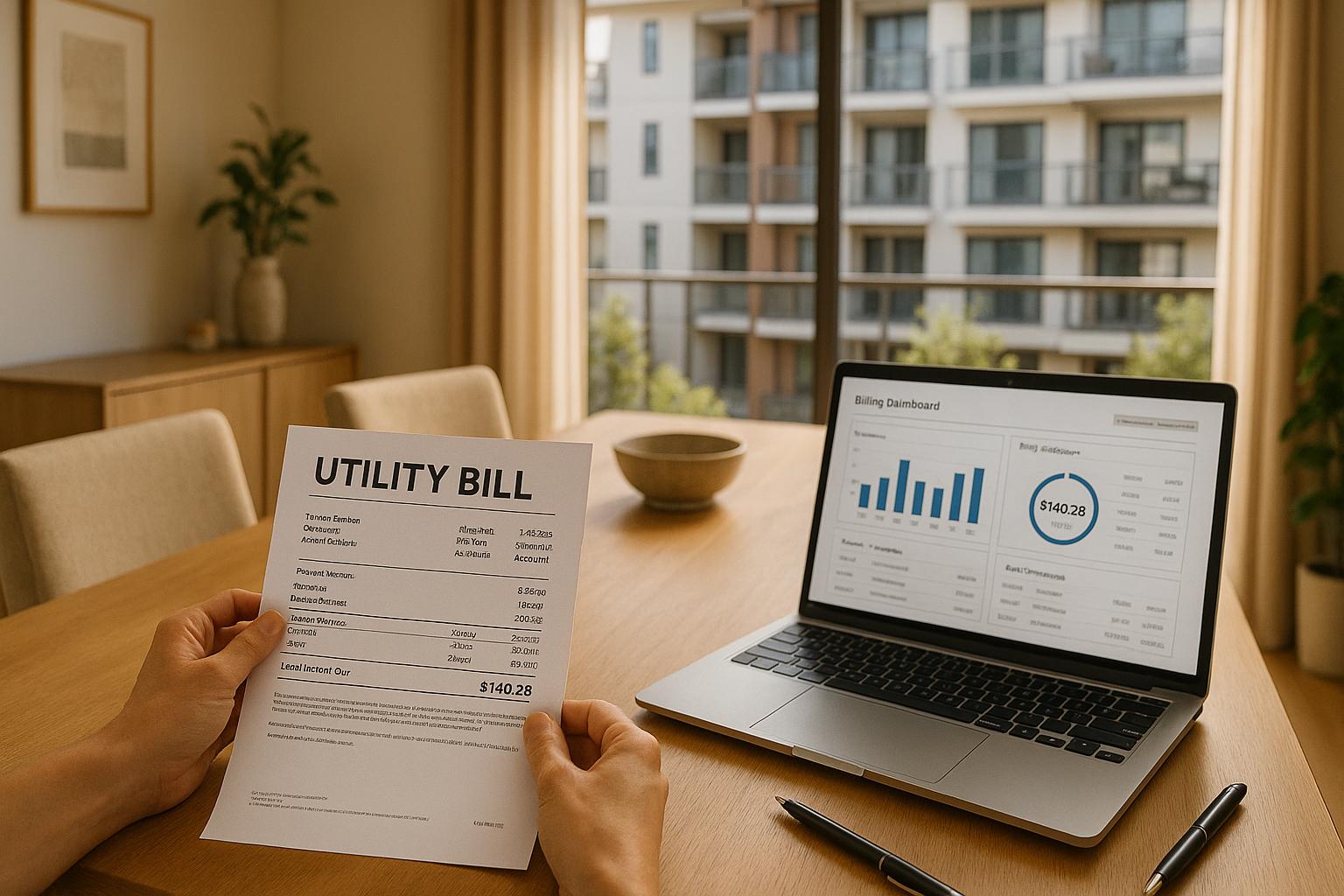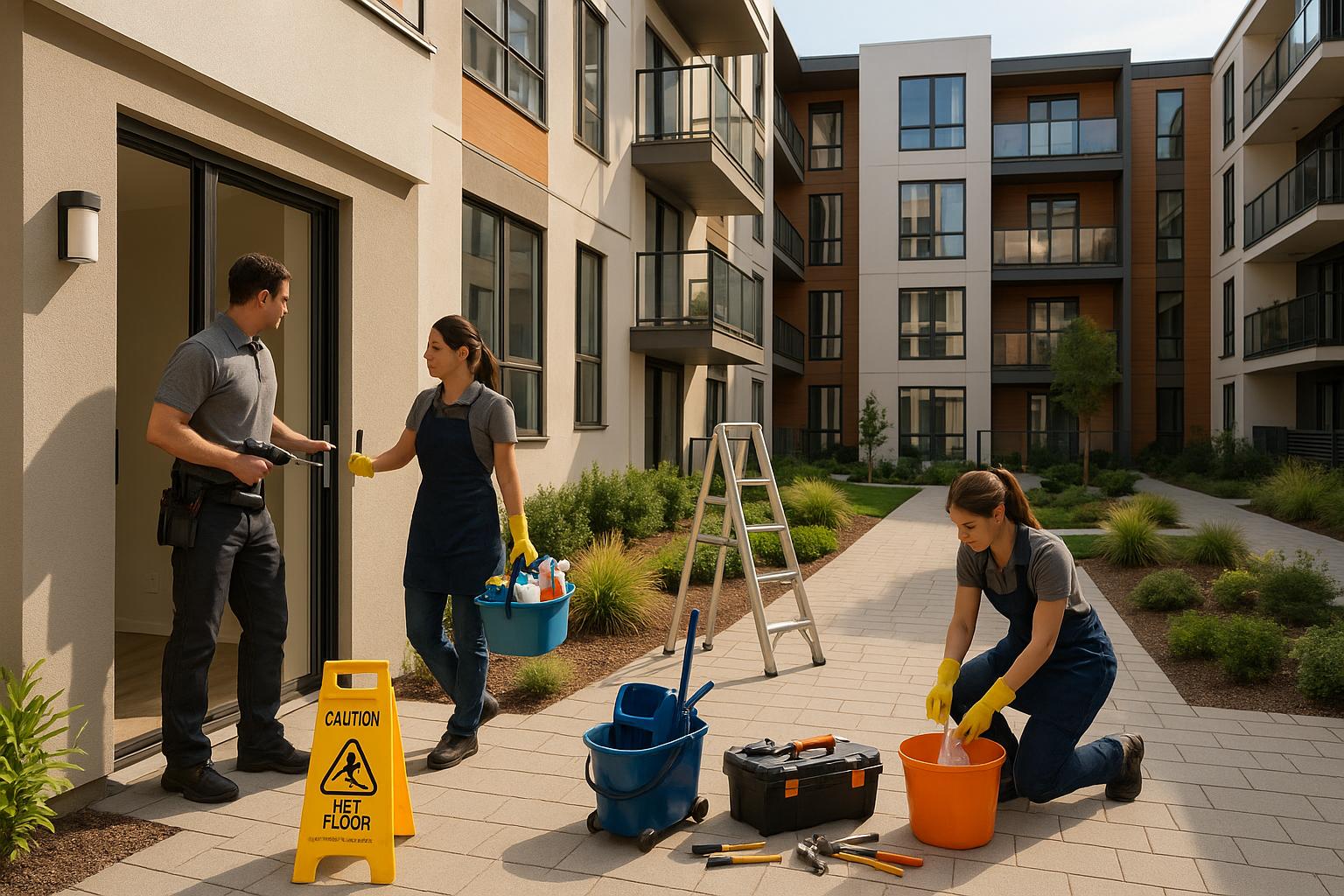E-commerce growth has caused a surge in package deliveries, creating logistical challenges for large multifamily properties. With residents expecting secure, 24/7 access to their packages, smart package room technologies have become a necessity. These systems reduce staff workload, prevent theft, and improve resident satisfaction. Here's a quick look at the most popular solutions:
- Smart Parcel Lockers: Automate package storage and retrieval, saving staff time and reducing theft.
- Access Control Systems: Combine video intercoms, mobile access, and PIN codes for secure deliveries.
- AI-Based Sorting: Speeds up package processing and minimizes errors using machine learning.
- Resident Notification Tools: Send real-time alerts and provide seamless communication through apps and texts.
Top vendors offering these solutions include ParcelPending, Luxer One, Amazon Hub, Smiota, and FP Smart Lockers. Each system offers unique features like biometric security, modular designs, and integration with property management software. Properties that adopt these technologies report higher resident retention, reduced theft, and streamlined operations.
Best Package Room Solutions 2025
Smart Parcel Locker Systems
Smart parcel lockers have become a cornerstone for handling packages in large multifamily properties. These systems consist of secure, modular cabinets with lockable compartments, allowing couriers to deliver packages directly into assigned units. Residents can then retrieve their deliveries anytime, day or night, using secure access codes sent via text or email [11].
By automating package delivery, smart lockers eliminate the need for property staff to handle packages manually, saving time and streamlining operations. For instance, Jamboree Management rolled out smart lockers at seven properties and saved up to 24 labor hours per week while drastically reducing package theft [10]. Similarly, at Optima Camelview, a 700-unit condominium community in Scottsdale, Arizona, staff time spent on parcel management dropped by 66% after implementing a smart locker system [9].
Security is another major advantage. Nearly half of apartment and townhome residents report experiencing package theft [11]. Smart lockers tackle this issue by maintaining a detailed record of every delivery. Plaza Hills, managed by FirstService Residential, saw a complete end to property damage from attempted package theft after adopting a smart locker solution [9].
These systems also handle high delivery volumes with ease. Brickell on the River, a luxury condominium in Miami, processes over 6,000 packages monthly through its smart lockers, significantly reducing staff involvement while accommodating large-scale deliveries [9].
The financial benefits are equally compelling. For example, The Flats at MacArthur, a 288-unit community, recouped its smart locker investment within two years by adding a small amenity fee to residents' rent [10]. Venterra Realty took a similar approach, incorporating storage fees into utility bills and automating delivery notifications, which contributed to occupancy rates increasing by 1–2% [10].
Modern systems come packed with features like built-in security cameras, mobile connectivity, and refrigerated compartments for temperature-sensitive items like groceries or medications [4]. Some even allow for consolidated deliveries, enabling residents to receive multiple packages from the same carrier in a single locker compartment [9].
Resident satisfaction also benefits significantly. Studies show that smart lockers can boost lease renewals by up to 40%, with 78% of residents preferring them as their go-to package delivery solution [4][10]. Christopher Young, Regional Supervisor at Winther Investments, highlighted this impact, saying their Parcel Pending lockers across 11 properties "truly got us out of the package business; we are literally making our residents happier with this amenity" [10].
While installation costs range from $5,000 to $21,000, leasing options are often available [6][10]. The industry is growing rapidly, with the global smart locker market projected to hit $1.2 billion by 2025 [7].
When evaluating smart locker systems, properties should consider factors like daily package volume, available space, compatibility with existing management software, and scalability for future needs. Once seen as a luxury, smart lockers are now essential infrastructure for improving resident retention and streamlining operations.
Access Control and Security Features
Smart parcel lockers are just one piece of the puzzle when it comes to creating a secure, modern mailroom. Pairing these with strong access control systems completes the picture, offering a comprehensive solution for managing deliveries and building access in multifamily properties. These systems don’t just regulate who enters the building - they also track movements, ensuring both people and packages are secure. With 53% of multifamily residents voicing concerns about physical security, access control has shifted from being a luxury to an absolute must-have [14].
One standout tool in this space is the video intercom system, which combines voice and video communication. These systems let residents verify visitors before granting access, offering an extra layer of security. Unlike older intercoms, today’s models connect directly to smartphones, allowing residents to remotely manage deliveries - even if they’re not home. Features like delivery PINs and temporary access codes also simplify the process for couriers. Property managers can issue time-sensitive codes, ensuring delivery personnel can access designated areas without compromising long-term security. Plus, these systems automatically generate audit trails, documenting who entered and when.
The financial stakes are high, too. With billions of dollars lost annually to package theft, access control systems are a critical defense against unauthorized entry. Beyond preventing theft, they help deter vandalism and burglaries, ultimately enhancing the safety and peace of mind for residents [13][15].
At Oxford Vista Apartments, the implementation of a ProdataKey system is a great example of how these technologies work in practice. Covering 30 access points, including exterior doors and parking gates, the system has significantly improved safety. Residents have expressed increased satisfaction with these upgrades [15].
Mobile access control is another game-changer, turning smartphones into digital keys. In June 2024, Salto introduced the DBolt, a smart lock designed specifically for multifamily housing. This system replaces traditional deadbolts without requiring new wiring, using existing lock holes for quick and cost-effective installation. Operating on Salto's proprietary SVN (Salto Virtual Network) technology, the DBolt communicates through user credentials like key cards, fobs, or smartphones - no constant internet connection needed [16].
"Users take information to the lock on the memory of their credential, whether it's a key card, a key fob, or their phone. For retrofits, this means there's no need for the expense of a wireless infrastructure gateway. We simply have one of our Authorized Business Partners go in, take out the old deadbolts, and install the new DBolt locks with almost no disruption." - Preston Grutzmacher, Residential Business Leader for Salto North America [16]
Beyond physical hardware, integration with property management systems takes access control to the next level. These systems can automatically grant or revoke access permissions based on a resident's move-in or move-out status, saving time for property managers while ensuring security. They also provide detailed audit trails, making it easier to investigate any security incidents.
Some advanced systems even include visitor management features, pre-screening guests and tracking their movements. For instance, The MET, a large community in Vaughan, Ontario, adopted a Protege GX solution in February 2025. This system uses ICT Entry Stations as digital doormen, allowing visitors to contact their hosts through the Protege Mobile App while concierge staff efficiently handle deliveries [17].
For maximum protection, many properties adopt a layered security approach, combining access control with surveillance cameras and strategic environmental design. High-security OSDP readers, fail-safe locks that remain secure during power outages, and integrated CCTV systems work together to safeguard both residents and their packages. This setup is particularly convenient for property managers overseeing multiple buildings, as they can grant or revoke access remotely, from anywhere.
"The goal is to let people in - in a safer, more convenient, and smarter way." - Preston Grutzmacher [16]
When choosing an access control system, properties should consider factors like compatibility with existing infrastructure, scalability for future expansion, and integration with other building technologies. The best systems strike a balance: they’re secure enough to block unauthorized access but convenient enough to ensure smooth, hassle-free deliveries.
AI-Based Sorting and Automation
AI-powered sorting and automation are changing the way large multifamily properties manage the ever-growing influx of deliveries. Building on the secure access and smart locker systems already in use, these advanced tools address the challenges posed by rising package volumes.
By leveraging computer vision and machine learning, these systems can identify, categorize, and route packages with impressive accuracy. This not only speeds up the sorting process but also minimizes the errors often seen with manual methods.
Take FedEx, for instance. They’ve introduced AI-driven sorting robots equipped with advanced computer vision to quickly and accurately process packages. These robots can even spot damaged or mislabeled items before they reach residents, ensuring higher service quality [18]. Similarly, Amazon’s AI-powered robots are designed to cut order fulfillment times by up to 25% and improve inventory identification and storage efficiency by as much as 75% [18]. For multifamily properties dealing with hundreds of packages weekly, these advancements translate into faster processing times and happier residents.
Real-world results back this up. A high-rise apartment complex that adopted a comprehensive mailroom management software saw a 50% drop in package-related complaints and a 70% reduction in package handling time [21]. This kind of improvement marks a major shift in how package rooms operate.
AI doesn’t stop at sorting. It also uses predictive analytics to optimize staffing and space allocation during peak delivery times, helping reduce inefficiencies. Route optimization is another game-changer. For example, UPS’s AI-driven system has saved about 100 million miles and 10 million gallons of fuel annually by streamlining delivery routes [18].
One of the most exciting aspects of AI is its ability to learn and adapt. Through machine learning, these systems continuously refine their processes to keep up with new scenarios and evolving resident needs [22]. This frees up property staff to focus on more meaningful tasks, like resident services and maintenance. As Mo Cheema, Director of Solutions Design and Implementation at Position Imaging, puts it:
"Technology is best utilized when eliminating boring, repetitive jobs that humans don't enjoy doing anyway." [20]
AI also provides property managers with valuable insights. By analyzing data, these systems can uncover package trends, resident preferences, and optimal delivery times. This information helps managers plan space usage and staffing schedules more effectively [21]. Additionally, AI-powered quality control systems ensure packages are inspected for damage or mislabeling with precision, reducing complaints and easing the workload on staff [18].
With e-commerce sales soaring by 43% in 2020 [19], the demand for efficient package management systems is higher than ever. AI-based sorting and automation aren’t just helpful - they’ve become essential for properties aiming to manage modern delivery volumes while keeping residents satisfied. This level of automation also lays the groundwork for smarter, more responsive resident notifications in today’s mailrooms.
Resident Notifications and Digital Management Tools
Automated resident notifications and digital management platforms are now at the heart of modern package room operations, reshaping how properties handle communication and delivery tracking. These tools have significantly reduced the constant influx of calls and inquiries that once overwhelmed property staff, making life easier for both employees and residents.
Today’s renters expect quick and efficient communication. In fact, 79% of American renters prefer property managers to respond via direct message, text, or chat, while 46% prioritize remote communication over onsite staffing [25]. This shift in expectations has made digital tools indispensable for property management.
One of the key features of these systems is real-time notifications, which ensure residents are instantly informed when a delivery arrives. Alerts sent via text, email, or mobile app include package details and pickup instructions. For instance, MRI Software’s package tracking system delivers an average of 323 package notifications per month and sends 469 messages through phone, text, or email bulletins [26].
But these platforms do more than just send alerts. Using advanced scanning technology, modern systems can process over 39 packages per minute [27], drastically cutting down the time spent on manual tracking. This efficiency translates into real savings, with package concierge teams reclaiming an average of 15 hours per week [27]. Such tools are designed to integrate multiple functions into a single, streamlined platform.
Take Building Logistics, for example. Their platform uses Optical Character Recognition (OCR) to instantly scan package labels, notify recipients with delivery details, and even include a photo of the package [28]. This kind of automation not only speeds up operations but also enhances accuracy and convenience.
The integration capabilities of these tools are a game-changer for property staff. Wendi McClanahan, Business Manager at Olympus Property, highlights this by saying:
"My favorite thing about MRI's Callmax solution is being able to bundle Bulletins and Package Tracking inside the same product." [26]
Some platforms also include emergency communication features. For instance, Notify automatically escalates emergency calls. If a maintenance staff member doesn’t respond, the system contacts the on-site manager repeatedly for up to 24 hours to ensure the issue is addressed promptly [23].
Beyond notifications, these tools offer detailed reporting and auditing features. Property managers can analyze package management trends to make smarter decisions about staffing and space allocation [27]. Automated communication also reduces the administrative load, freeing up staff to focus on more complex tasks.
For residents, the convenience is undeniable. Many platforms allow users to handle all package-related needs through a single app - whether it’s tracking deliveries or scheduling pickups [27]. This shift toward comprehensive digital self-service reflects a growing demand for simplicity and efficiency.
When adopting these systems, property managers should prioritize platforms that offer SMS updates, mobile app integration, and compatibility with existing property management software [25]. The goal is to create a unified system where package information stays up to date across all channels, minimizing errors and improving the resident experience.
As Sarah Bonder from Livly puts it:
"Once residents experience true smart living, they don't want to go back. No one likes a downgrade." [24]
This sentiment captures why digital management tools have become the standard in large multifamily properties. Their ability to deliver convenience and efficiency has set a new benchmark that residents now expect as part of their living experience.
1. ParcelPending
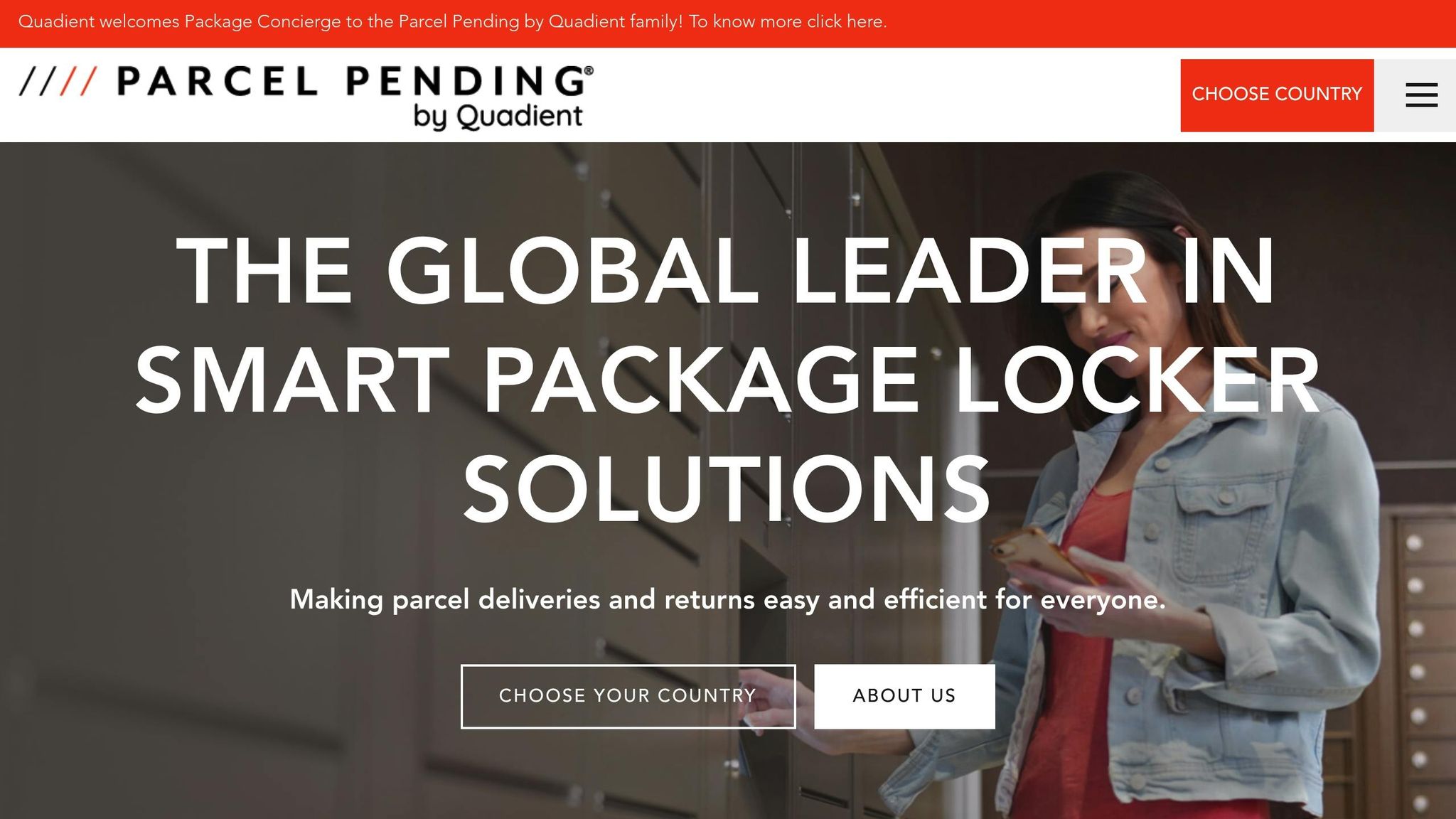
ParcelPending stands out as a major player in the smart locker industry, handling over 72 million parcels annually for more than 5 million users across the United States [32]. With over a decade of proven reliability in large multifamily properties, it's become a trusted name for secure and efficient package management [4].
Security Features
Package theft is a growing issue, with an estimated 119 million incidents reported in 2023, and 75% of victims experiencing theft within the past year [30]. ParcelPending tackles this problem head-on with advanced security measures designed to protect deliveries.
Each locker is equipped with strong locks, surveillance features, and sensors that sync with ParcelPending's property management portal. This setup allows for real-time monitoring of suspicious activity [4]. Deliveries are secured with unique access codes sent instantly to recipients, ensuring only authorized individuals can retrieve their packages [29].
"ParcelPending's multifamily package lockers are designed with advanced security features to prevent package theft and ensure safe and secure package storage." [4]
A real-world example of its effectiveness comes from FirstService Residential in Kansas City, Missouri. Facing significant package theft, the property installed two outdoor locker towers with 25 lockers near their USPS mail kiosk. This simple change eliminated theft, improved resident satisfaction, and cut costs related to property damage [31].
Resident Convenience
ParcelPending goes beyond security, offering residents a seamless and hassle-free experience. The system provides 24/7 access to packages and sends automatic notifications when deliveries arrive [32]. Residents receive alerts via email or mobile, complete with a unique access code or barcode for pickup [29].
The mobile app adds even more convenience, allowing users to manage deliveries, receive real-time updates, and retrieve packages using barcode scanning or Bluetooth [33]. For larger items, ParcelPending accommodates oversized packages and overflow deliveries with secure package rooms [4]. A handy vacation mode also allows residents to pause storage fees while they're away [34].
Karen C., a resident from Englewood, Colorado, shares her experience:
"What I love most about using a ParcelPending smart locker is the convenience. Everything is in one place, and you get a friendly reminder if you haven't picked up your packages – which is so helpful with my work schedule." [32]
Andy, a resident from Miami, Florida, adds:
"If I had a word to describe ParcelPending, it would be life-saving. Why? Because it's quick, convenient, and the customer service has been amazing." [32]
Staff Efficiency
ParcelPending doesn't just benefit residents - it also transforms property staff operations. By automating package management, it saves staff up to 24 hours per week [4]. Deliveries are placed directly into lockers by carriers, triggering automated notifications for residents and eliminating the need for manual sorting [3].
At Optima Camelview, a 700-unit community in Scottsdale, Arizona, the concierge team previously spent nearly nine hours daily managing packages. After installing ParcelPending, they cut this time by 66% [3][9]. Similarly, Brickell on the River, a luxury condominium in Miami, processes over 6,000 packages monthly and reduced staffing needs thanks to the lockers [3][9].
Eric Holley, Residential Property Manager at Miller Valentine Group, highlighted the impact:
"From an office standpoint, ParcelPending has really helped with maximizing our office efficiency. It actually allows us to devote more time to bettering the resident experience in other ways." [4]
Brian Peterson, Property Manager at Security Properties Residential, echoed this sentiment:
"The lockers take the majority of my package handling out of my associates' hands, which increases productivity as well as security for my residents' packages." [4]
Scalability
ParcelPending is built to grow with the needs of properties, offering flexible locker configurations to accommodate different layouts and package volumes [32]. Its seamless integration with property management software ensures a smooth expansion without disrupting daily operations [4].
The company also provides thorough training for both couriers and property staff, ensuring the system runs efficiently even with team changes or property growth [4]. Studies have shown that adding package lockers can boost lease renewals by as much as 40% [4], making ParcelPending a strategic investment for properties looking to enhance resident retention in competitive markets.
sbb-itb-58157f8
2. Luxer One
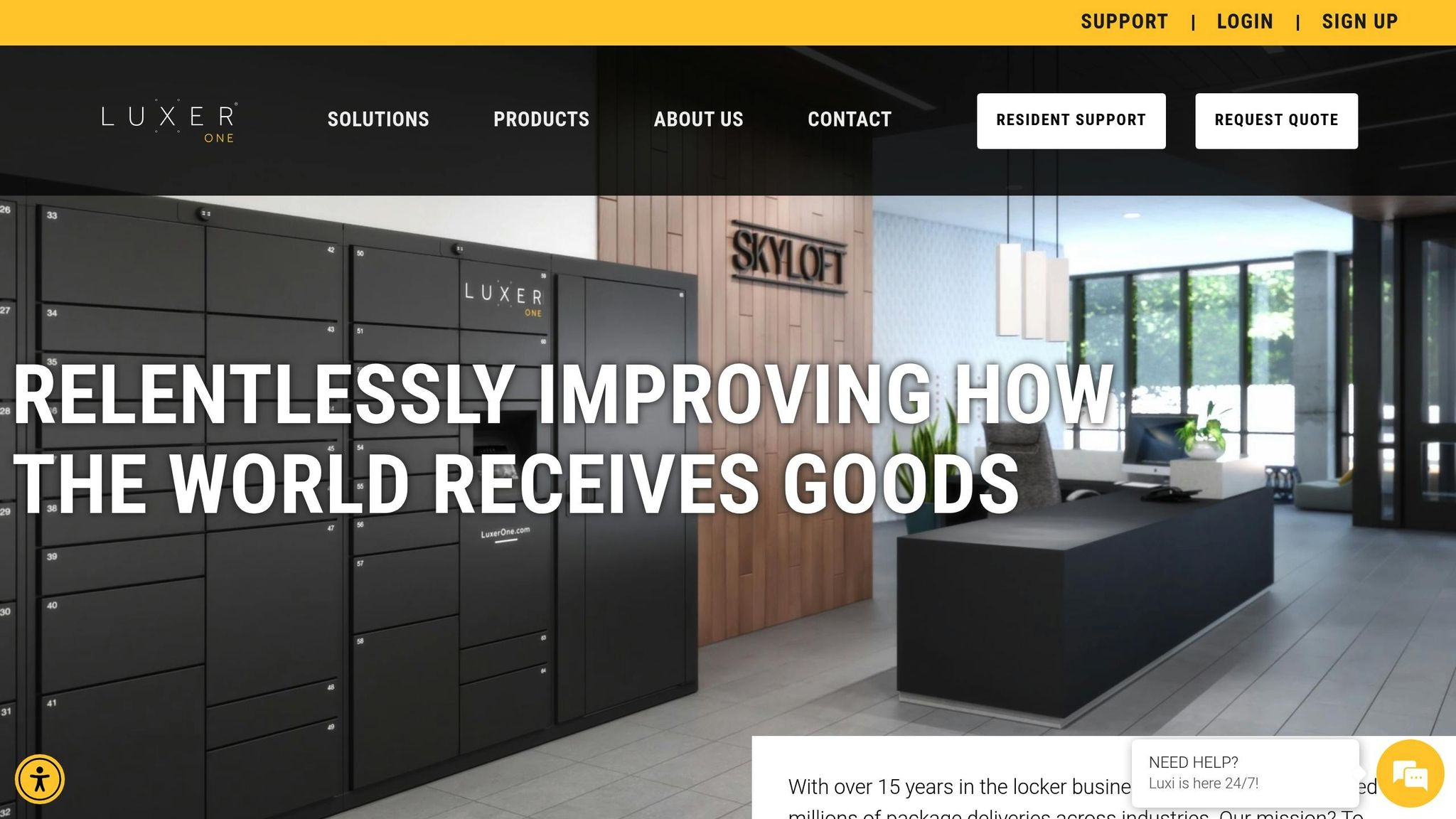
Luxer One has carved a niche in the multiresidential market by addressing the core challenges of package management: security, convenience, and efficiency. Recognized as the top package locker solution for multifamily properties in the 2018 Package Delivery Report by NMHC & Kingsley Research [38], Luxer One has proven its value in large residential communities by tackling the growing demands of e-commerce deliveries.
Security Features
With package theft on the rise - 91.9 million packages were stolen across the U.S. in 2024, resulting in nearly $16 billion in losses [37] - Luxer One has taken security to the next level. Each locker system is equipped with high-definition security cameras, tamper-proof locks, and unique access codes for every delivery [35]. For outdoor installations, the lockers feature tamper-proof steel construction and secure access via individualized codes. One property even reported a dramatic drop in theft after creating a secure apartment mailroom with Luxer One's support [36].
"I've been with the Postal Service for 16 years and these lockers are a game changer. They keep all the packages safe and sound." - Gerardo S., USPS Delivery Carrier [12]
Resident Convenience
Luxer One ensures residents can access their packages anytime with its 24/7 availability and a 99.9% uptime guarantee [12][38]. Delivery notifications are sent via text or email, complete with a PIN for secure retrieval [39]. The system accommodates packages of various sizes, featuring an automatic door that opens with a PIN or QR code, all operated through an intuitive iOS-powered touchscreen [38][39].
"I LOVE Luxer One. It works perfectly. My boxes are held for me, I get a text with the code to open the locker, and I can access them anytime. If I go away on vacation, I can put a vacation hold, and the packages will be held in the lockers until I get back." - Rachel E., Resident [12]
Staff Efficiency
Managing package deliveries in high-volume properties - where 50 to 100 packages arrive daily [40] - can be overwhelming. Luxer One simplifies this process with its smart lockers and automated package rooms, which reduce manual handling and notify residents as soon as their packages arrive [36][42]. The system is designed to accept all deliveries, cutting down on staff involvement and keeping package areas organized [12][40]. For properties needing extra help, Luxer Liaison services provide on-site support, including audits and resident communications [40][42].
Dina S., a property manager at Mirabella Apartments, shared her experience:
"Luxer One has been a godsend! Package management today is so different from how it used to be. You absolutely need a package management solution, and for us, Luxer One has been the holy grail. I could never imagine going back." [12]
Scalability
As package volumes grow alongside the booming e-commerce market - which reached $4.8 trillion globally in 2023 and is projected to hit $9 trillion by 2032 [40] - Luxer One offers solutions that adapt to changing needs. The company provides smart lockers, package rooms, and Luxer Liaison services that can be tailored to a property’s specific requirements [41][42]. Flexible billing plans, regular audits, and standardized procedures ensure properties remain efficient as delivery demands increase [41][42].
Whether it’s a small complex or a sprawling community, Luxer One’s systems are designed to grow alongside the properties they serve.
3. Amazon Hub
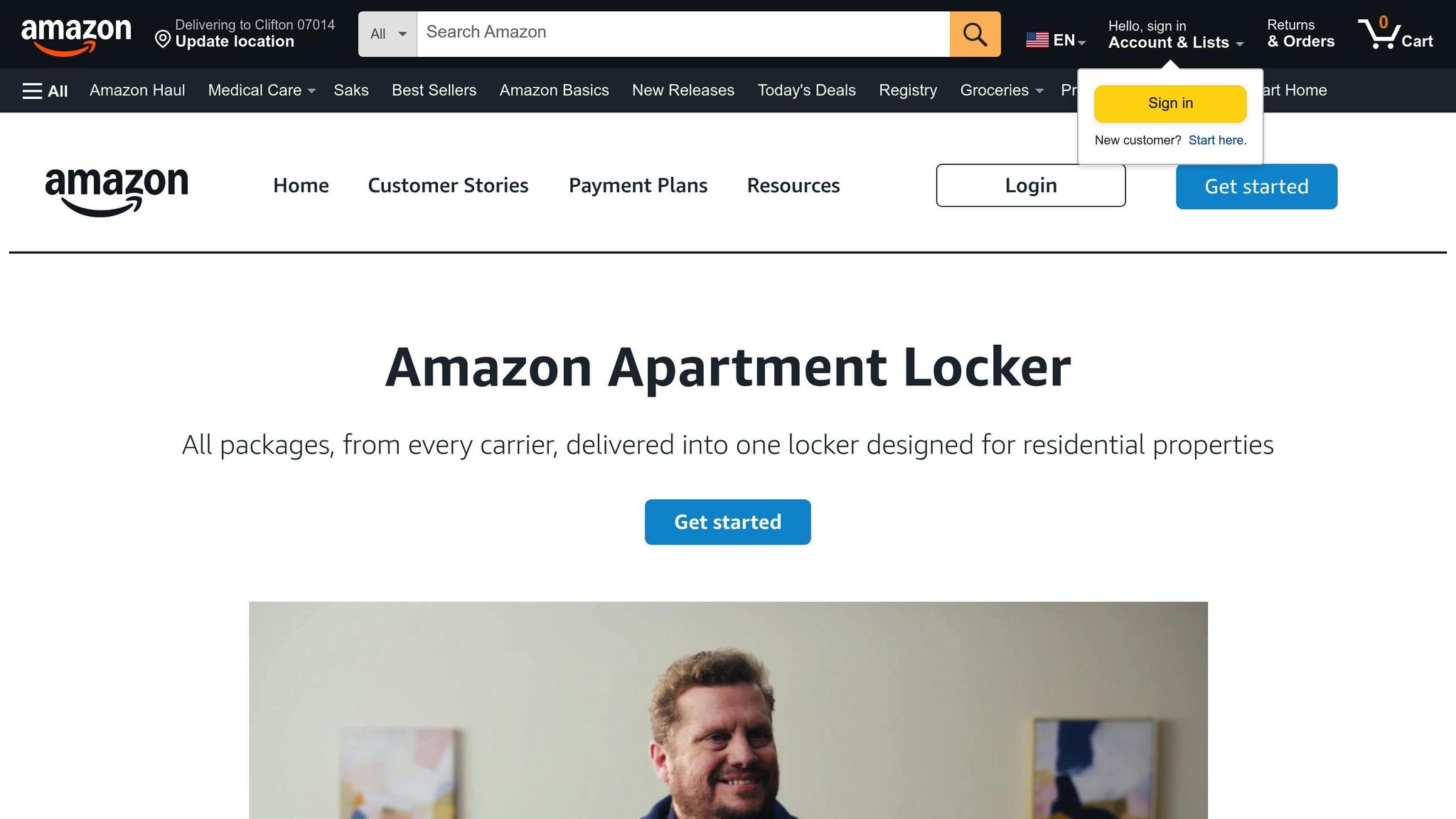
Amazon Hub Apartment Lockers have become an essential solution for large multifamily properties. Considering that Amazon handles 50% of all retail sales in the U.S. and 47% of millennials order from Amazon at least once a week [44], managing the flood of packages at these properties has become a top priority. With hundreds - or even thousands - of deliveries arriving weekly, efficient package handling is no longer optional.
Security Features
Package theft is a growing issue, with over 58 million packages stolen across the U.S. in 2024 [49]. Amazon Hub tackles this challenge by offering secure lockers with access controlled by individual passcodes [48]. Each delivery is assigned a unique pickup code, ensuring packages remain protected until retrieved [45]. On top of that, Amazon handles regular maintenance and cleaning of the locker area, adding an extra layer of reliability.
As Corey Colleton from Security.org explains:
"It's a crime of opportunity." [49]
By eliminating these opportunities, Amazon Hub significantly reduces the risk of theft while providing peace of mind to residents. And while security is a top priority, the system also offers unmatched convenience.
Resident Convenience
Amazon Hub lives up to its promise: "Secure, 24/7 package access with a locker designed for every carrier and every residential building" [43]. Unlike traditional package rooms with limited hours, residents can pick up their deliveries at any time, day or night [45]. Plus, the lockers are compatible with all major carriers, ensuring a one-stop solution for all shipping needs [45].
Getting started is straightforward. Residents simply register through their building’s property manager, and there are no extra fees for using the system [45]. Once a package arrives, residents receive a notification with a unique pickup code or barcode, making retrieval quick and hassle-free [46].
Staff Efficiency
Beyond security and convenience, Amazon Hub significantly lightens the workload for property staff. Managing packages in a building with 300 or more units can be overwhelming, especially when high-rise properties receive hundreds - or even thousands - of deliveries each week [44]. By automating 99% of package handling, Amazon Hub eliminates the need for a full-time mailroom employee, a role that typically costs $30,000 to $40,000 annually [44].
This automation reduces clutter in common areas and frees up staff to focus on other responsibilities, streamlining property operations [47].
Scalability
Amazon Hub’s modular design makes it adaptable for properties of all sizes [43]. The base unit, which measures 6 feet wide by 1 foot 10 inches deep, includes 42 compartments [46]. For higher package volumes, additional expander units (3 feet wide, 1 foot 10 inches deep, 23 compartments) can be added [46].
The initial investment ranges from $10,000 to $20,000, covering shipping, installation, and onboarding, with no monthly fees [44]. For properties already using another locker system, switching to Amazon Hub typically doesn’t involve significant extra installation costs [44].
This flexibility allows property managers to start small and expand as needed, making Amazon Hub a practical and scalable solution for growing package demands. Its modular design fits seamlessly into the modern property management landscape.
4. Smiota
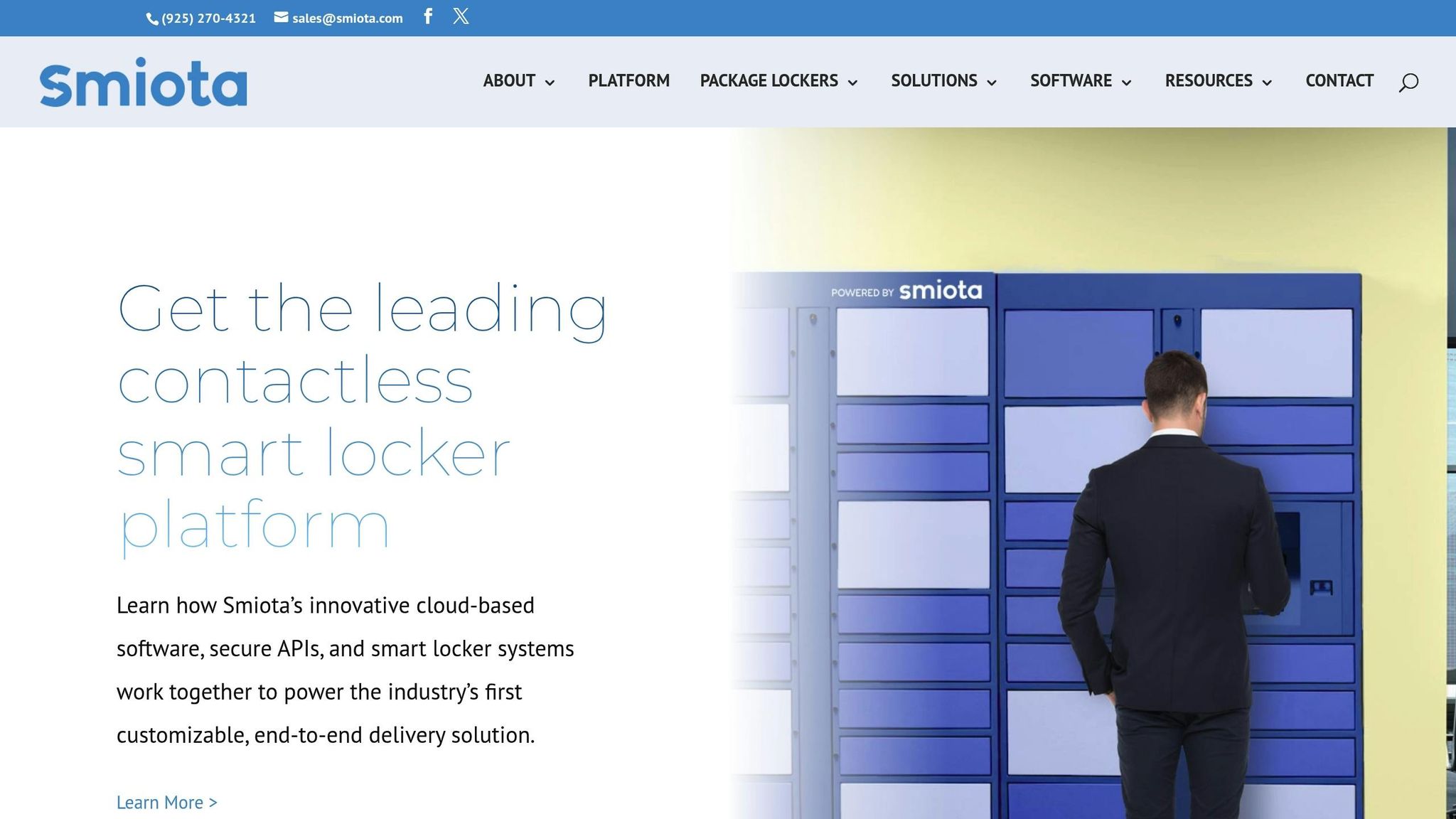
Smiota has positioned itself as a robust package management solution tailored for large multifamily properties. Its smart lockers and automated systems are designed to handle the high volume of deliveries these properties often face. The platform focuses on three key areas: security, resident convenience, and operational efficiency.
Security Features
Package theft is a growing issue, with nearly one in seven Americans falling victim to stolen packages in 2022, leading to an estimated $19.5 billion in losses [50]. To tackle this problem, Smiota employs several advanced security measures. These include role-based access, strict password protocols, OAuth token-based authentication, and TLS 1.2 encryption. The lockers themselves are built with heavy-gauge steel for added physical security. Continuous system monitoring further enhances safety by generating automated reports on locker integrity, hardware issues, and any break-in attempts [50]. Additionally, the platform integrates mobile device management powered by 2Gears, offering an extra layer of security [50]. Together, these features ensure a secure and seamless experience for residents.
Resident Convenience
Smiota makes package pickup effortless with 24/7 access and contactless technology. Residents are notified automatically when their packages arrive and receive reminders to pick them up promptly [8]. The smart lockers allow for quick, hassle-free pickups, taking just seconds and eliminating the need to stand in line. Couriers can also consolidate multiple packages for a single resident into one locker compartment, simplifying the process further [8]. Ellen De Lune, VP at LIVEbe Communities, shared her perspective on implementing Smiota:
"We believe package lockers are a state-of-the-art amenity that will provide a true benefit to our residents." [51]
Staff Efficiency
For properties that handle hundreds of deliveries daily, Smiota's automation is a game-changer. The system takes care of tasks like package logging, sorting, and notification delivery, significantly easing the workload for property staff [2]. Kevin Hott, VP of Information Systems & Technology at E&S Ring Management Corp, commended the platform:
"We chose Smiota for their highly innovative package delivery platform that offers our residents a great package experience and excellent 24/7 customer support." [8]
The platform’s point-and-scan technology speeds up the process for couriers, capturing recipient names and tracking numbers in under five seconds. Staff can oversee operations through a user-friendly web portal, which provides access to resident details and locker analytics. Warren Porter, a Higher Education Consultant, highlighted the benefits of Smiota at a university:
"Introducing Smiota's package management solution significantly reduced the time taken to process hundreds of packages received daily." [51]
This level of automation not only improves efficiency but also sets the stage for scaling operations.
Scalability
Smiota’s platform is designed to grow alongside the property’s needs. Its flexibility allows couriers to drop off multiple packages in one location, and the system can expand without requiring a full infrastructure overhaul [8]. The web portal gives property managers valuable insights into usage patterns, helping them optimize capacity and prepare for seasonal spikes in delivery volumes [8]. Whether it’s a small property or a large complex, Smiota’s adaptable system ensures smooth and efficient package management [52].
5. FP Smart Lockers
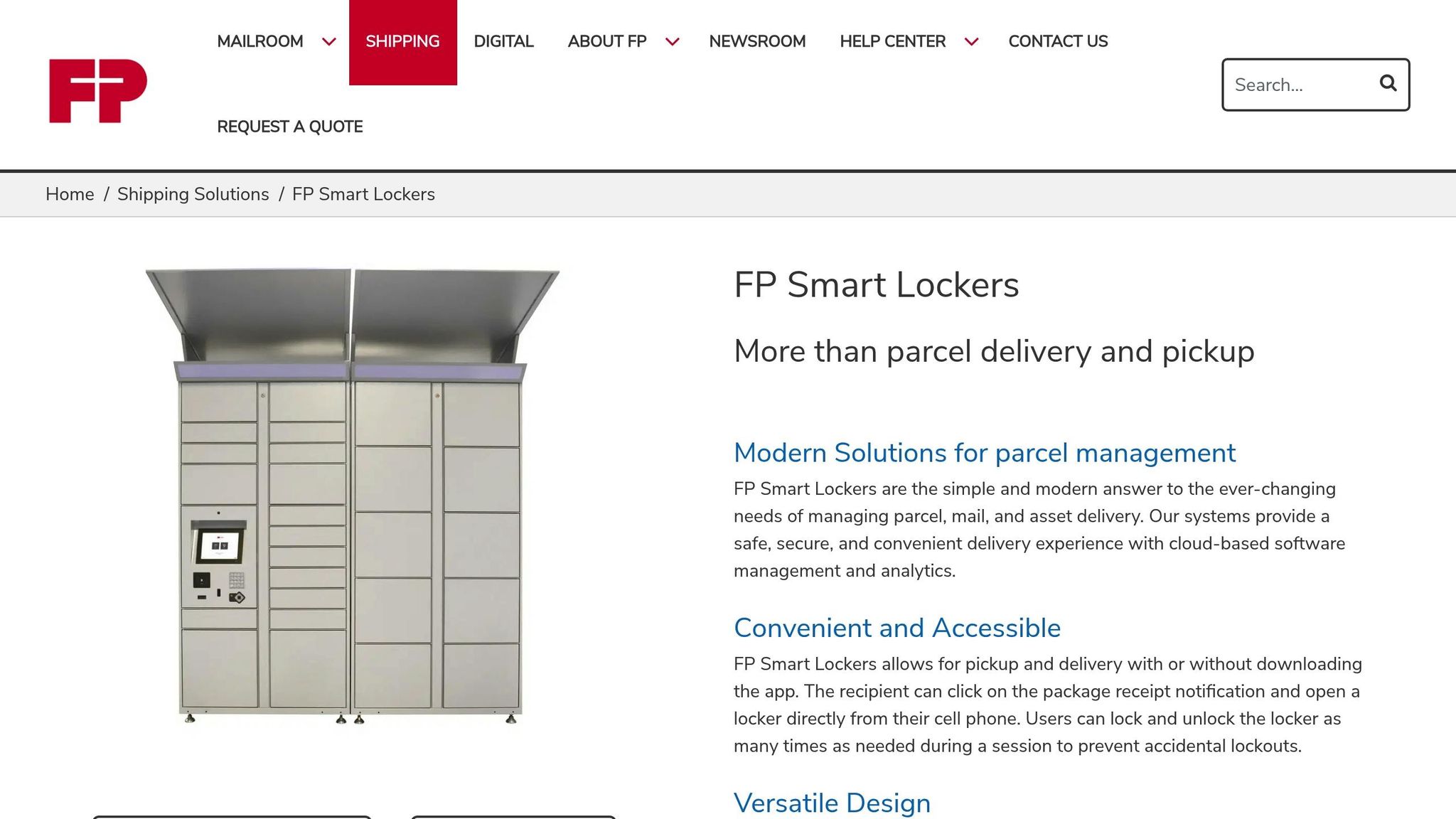
FP Smart Lockers takes package management to the next level, offering a smart, integrated solution tailored for large multifamily properties. By combining advanced security features with user-friendly technology, it handles high delivery volumes with ease. Its customizable setup ensures that each property can meet its specific needs.
Security Features
Package theft is a growing problem - over 49 million Americans reported stolen packages in 2022 alone [5]. FP Smart Lockers tackle this issue head-on with a multi-layered security system. Features include biometric scanning, embedded cameras, tamper-evident locking mechanisms, and QR/barcode authentication. As security expert Bruce Schneier wisely puts it:
"Security is not a product, but a process" [53].
These features work together to provide peace of mind for both residents and property managers.
Resident Convenience
With FP Smart Lockers, residents enjoy 24/7 access to their packages. Notifications and secure access codes are sent directly to smartphones or displayed on an integrated touchscreen, making package retrieval quick and hassle-free.
Staff Efficiency
The system automates package logging, secure storage, and notifications, significantly reducing the workload for staff and couriers. This automation not only saves time but also ensures smoother day-to-day operations.
Scalability
FP Smart Lockers are designed with growth in mind. Their modular framework allows property managers to customize locker configurations and expand capacity as needed. TRAX software enhancements and a weatherproof design make them suitable for both indoor and outdoor use. Plus, seamless integration with existing management systems ensures an easy transition [54][55].
FP Smart Lockers provide a reliable, scalable, and secure solution for modern package management.
Feature Comparison Table
Here’s a breakdown of key features across different systems to help you decide on the best option for managing your 300+ unit property.
| Feature | ParcelPending | Luxer One | Amazon Hub | Smiota | FP Smart Lockers |
|---|---|---|---|---|---|
| Security Features | PIN codes, access cards, CCTV integration | Biometric scanning, tamper alerts, encrypted access | Proprietary security protocols, delivery confirmation | Biometric authentication, end-to-end encryption, configurable access levels | Biometric scanning with multiple verification methods |
| Resident Access | 24/7 with mobile notifications | 24/7 with app-based notifications | 24/7 through Amazon app integration | 24/7 with biometric verification | 24/7 with smartphone notifications and touchscreen interface |
| Staff Impact | Significantly reduces manual sorting | Automated logging and notifications | Minimal staff involvement required | Streamlined operations with audit trails | Automated package logging and secure storage |
| Scalability | Modular expansion available | Indoor/outdoor configurations, multiple capacity options | Limited to Amazon ecosystem | Highly customizable for enterprise deployments | Modular framework with TRAX software enhancements |
| Package Capacity | Standard capacity | Flexible sizing options | Fixed dimensions | Adaptable to various package sizes | Customizable locker configurations |
| Installation Requirements | Professional installation needed | Indoor and outdoor compatible | Amazon-managed installation | Integration with existing security systems | Weatherproof design for indoor/outdoor use |
| Biometric Authentication | Not available | Available on select models | Not available | Facial recognition, fingerprint scanning, palm vein mapping, iris detection | Multiple biometric verification methods |
| Integration Capabilities | Compatible with property management software | Multiple platform integration | Amazon ecosystem focused | Compatible with existing enterprise security and HR tools | Seamless integration with existing management systems |
When it comes to security, there’s a clear shift toward more advanced methods like biometrics. Systems such as Smiota and FP Smart Lockers are setting the pace, offering features like facial recognition and fingerprint scanning. These measures address the weaknesses of older systems, such as PIN codes or QR scans, which can be vulnerable to hacking or user error [56].
Scalability is another critical factor, especially with package volumes expected to rise by up to 21% in 2023 [57]. For properties with over 300 units, modular systems that adapt to fluctuating demand - especially during peak seasons - are essential. This flexibility ensures that growing communities can keep up with increasing package management needs.
Security approaches also vary widely. While some systems rely on traditional PIN codes and access cards, advanced options like Smiota use biometrics to ensure only authorized individuals can retrieve packages. This added layer of security creates traceable logs, which are valuable for compliance and reporting [56].
Automated features like logging and notifications further reduce the workload for property management teams, allowing them to focus on other resident services instead of being bogged down by package management tasks.
This comparison highlights how modern locker systems are transforming package management by improving security, simplifying access for residents, and reducing staff involvement.
Conclusion
The rapid growth of e-commerce has made modern package management an essential part of property operations, especially for buildings with 300 or more units. New technologies - ranging from modular systems to biometric authentication - are transforming how properties handle deliveries, improving both efficiency and security.
Take Stuyvesant Town in New York City as an example. After implementing a Smart Package Room system, they reduced their package management staff from 12 employees to just 2, while also cutting resident pickup times by an impressive 600% [59].
"With the Smart Package Room system, we went from 12 full time employees managing packages down to two!" - Magdalena Gross, General Manager, Stuyvesant Town, NY [59]
These systems don’t just save on staffing - they also handle two to three times the package volume of traditional lockers within the same physical space. Plus, they offer 24/7 access, eliminating the frustrations of limited office-hour pickups [58]. Advanced features like biometric authentication and real-time tracking add an extra layer of security, ensuring accountability for both residents and property managers.
On average, smart package systems reduce package management time by 75%, allowing staff to focus on tasks that enhance the community experience instead of sorting through deliveries [60]. This is especially critical given that 14% of on-site staff already rank package management among their top challenges [58].
For residents, these systems meet the expectations of a digital-first lifestyle. With 55% of renters citing package management as a key factor in their housing decisions and 37% willing to pay extra for premium services [1], features like contactless pickup, secure storage, and instant notifications are no longer just conveniences - they’re priorities.
FAQs
What are the key advantages of using smart package room technologies in large multifamily buildings?
Smart package room technologies bring a range of benefits to large multifamily properties. First and foremost, they improve security by ensuring packages are securely stored and accessible only to the rightful recipients. These systems also simplify package handling with features like AI-driven sorting and automated notifications, making deliveries quicker and more efficient.
For residents, the convenience of 24/7 access means they can retrieve their packages whenever it suits them. Meanwhile, property staff see a lighter workload, as the need for manual package management is significantly reduced. On top of that, these systems make better use of available space, efficiently managing higher package volumes without creating clutter.
How do smart parcel lockers improve security and prevent package theft in large apartment buildings?
Smart parcel lockers offer a reliable solution to package theft by keeping deliveries safe in sturdy, tamper-proof compartments. Access is limited to residents who can unlock the lockers using unique PINs, QR codes, or mobile app alerts. This ensures that only the intended recipient can retrieve their package.
Additionally, many of these systems come equipped with security features like cameras and motion sensors. These tools not only discourage theft but also allow for monitoring any activity around the lockers. By simplifying package handling and boosting security, these lockers provide a sense of ease for both residents and property managers alike.
What should property managers look for in a package management system for large multifamily buildings?
When choosing a package management system, property managers should prioritize security, user-friendliness, and how well the system integrates with their building's current infrastructure. The system should efficiently handle large delivery volumes, especially during busy periods, while ensuring residents receive prompt notifications about their packages.
It’s also important to think about scalability to meet future demands, the availability of vendor support for resolving issues, and whether the system fits within the budget. Don’t overlook compliance with local regulations, as well as the system’s ability to improve convenience and keep residents satisfied.
